Water Demand Determination for Landscape Using WUCOLS and LIMP Mathematical Models
Abstract
1. Introduction
2. Materials and Methods
2.1. Study Area Description
2.2. Decoupled Landscape Coefficient (KPLT) Approaches
2.2.1. WUCOLS Approach
2.2.2. LIMP Approach
2.3. Reference Evapotranspiration (ETr) Estimation
2.4. Water Depth Demand Estimation (WDD)
2.5. Data Source
2.6. Statistical Analysis Between WUCOLS and LIMP
3. Results
3.1. Enhancing Water Management in Arid Climates
3.2. Historical Climatic Parameters
3.3. Landscape Water Demand Estimation
4. Discussion
4.1. Historical Climatic Parameters
4.2. Landscape Water Demand Estimation
4.3. Exploring KPLT Component Scenarios: WUCOLS vs. LIMP
- Case 1: Exploring Ks (moderate) vs. Ksm (low) scenario
- Case 2: Exploring Ks (moderate) vs. Ksm (moderate) scenario
- Case 3: Exploring Ks (moderate) vs. Ksm (high) scenario
5. Conclusions
Author Contributions
Funding
Data Availability Statement
Acknowledgments
Conflicts of Interest
References
- Westall, F.; Brack, A. The Importance of Water for Life. Space Sci. Rev. 2018, 214, 50. [Google Scholar] [CrossRef]
- Al-Malki, W.M.; Al-Shamsan, S.I.; Al-Alewi, A.F.; Al-Shebil, M.A.; Al-Naser, I.S. Water problem and its implications for sustainable development. J. Econ. Adm. Leg. Sci. 2024, 8, 56–66. [Google Scholar]
- United Nations. Clean Water and Sanitation. 2022. Available online: https://unstats.un.org/sdgs/report/2023/Goal-06/ (accessed on 28 April 2025).
- Armstrong, M. Where Water Stress Will Be Highest by 2050. 2024. Available online: https://www.statista.com/chart/26140/water-stress-projections-global/ (accessed on 1 March 2025).
- El Kharraz, J.; El-Sadek, A.; Ghaffour, N.; Mino, E. Water scarcity and drought in WANA countries. Procedia Eng. 2012, 33, 14–29. [Google Scholar] [CrossRef]
- Oweis, T.; Hachum, A. Water harvesting and supplemental irrigation for improved water productivity of dry farming systems in West Asia and North Africa. Agric. Water Manag. 2006, 80, 57–73. [Google Scholar] [CrossRef]
- Gallardo, A.H.; Tase, N. Hydrogeology and geochemical characterization of groundwater in a typical small-scale agricultural area of Japan. J. Asian Earth Sci. 2007, 29, 18–28. [Google Scholar] [CrossRef]
- Partey, F.K.; Land, L.A.; Frey, B.; Premo, E.; Crossey, L. Final Report on the Geochemistry of Bitter Lake National Wildlife Refuge, Roswell, New Mexico; New Mexico Bureau of Geology and Mineral Resources: Socorro, NM, USA, 2011. [Google Scholar]
- McCabe, M.; AlShalan, M.; Hejazi, M.; Beck, H.; Maestre, F.T.; Guirado, E.; Peixoto, R.S.; Duarte, C.M.; Wada, Y.; Al-Ghamdi, S. Climate Futures Report: Saudi Arabia in a 3 Degrees Warmer World; KAUST, AEON Collective, KAPSARC: Thuwal, Kingdom of Saudi Arabia, 2023. [Google Scholar]
- Radwan, F.; Alazba, A. Integrated Hydrologic Study of the Arid and Semi-arid Regions using RST and GIS in the Riyadh Metropolitan Area, Saudi Arabia. J. Geol. Soc. India 2021, 97, 539–554. [Google Scholar] [CrossRef]
- Radwan, F.; Alazba, A.A.; Mossad, A. Flood risk assessment and mapping using AHP in arid and semiarid regions. Acta Geophys. 2019, 67, 215–229. [Google Scholar] [CrossRef]
- Al-Zahrani, K.H.; Baig, M. Water in the Kingdom of Saudi Arabia: Sustainable management options. J. Anim. Plant Sci. 2011, 21, 601–604. [Google Scholar]
- Armstrong, M. Where Groundwater Is (Not) Scarce. 2022. Available online: https://www.statista.com/chart/27274/water-stress-scarcity-current-situation/ (accessed on 1 March 2025).
- Elkatoury, A.; Alazba, A.A. Irrigation Water Demand Management-Based Innovative Strategy: Model Application on the Green Riyadh Initiative, Saudi Arabia. Water 2024, 16, 3559. [Google Scholar] [CrossRef]
- SGI. SGI Target: Grow 10 Billion Trees Across Saudi Arabia. 2021. Available online: https://www.sgi.gov.sa/about-sgi/sgi-targets/greening-saudi/ (accessed on 28 April 2025).
- Silva, J.A. Wastewater treatment and reuse for sustainable water resources management: A systematic literature review. Sustainability 2023, 15, 10940. [Google Scholar] [CrossRef]
- Al-Othman, A.A.; Kaur, P.; Imteaz, M.A.; Hashem Ibrahim, M.E.; Sillanpää, M.; Mohamed Kamal, M.A. Modified bio-electrocoagulation system to treat the municipal wastewater for irrigation purposes. Chemosphere 2022, 307, 135746. [Google Scholar] [CrossRef] [PubMed]
- Radwan, F.; Alazba, A.A. Suitable sites identification for potential rainwater harvesting (PRWH) using a multi-criteria decision support system (MCDSS). Acta Geophys. 2023, 71, 449–468. [Google Scholar] [CrossRef]
- Ezzeldin, M.; Alazba, A.A.; Alrdyan, N.; Radwan, F. Rationalizing Irrigation Water Consumption in Arid Climates Based on Multicomponent Landscape Coefficient Approach. Earth Syst. Environ. 2024, 9, 277–298. [Google Scholar] [CrossRef]
- Carlsen, L. Sustainability: An ethical challenge: The overexploitation of the planet as an exemplary case. Sustainability 2024, 16, 3390. [Google Scholar] [CrossRef]
- Snyder, R.L.; Pedras, C.; Montazar, A.; Henry, J.M.; Ackley, D. Advances in ET-based landscape irrigation management. Agric. Water Manag. 2015, 147, 187–197. [Google Scholar] [CrossRef]
- Shojaei, P.; Gheysari, M.; Myers, B.; Esmaeili, H. Quantifying microclimatic conditions: An attempt to more accurately estimate urban landscape water requirements. Urban For. Urban Green. 2020, 54, 126767. [Google Scholar] [CrossRef]
- Costello, L.R.; Matheny, N.P.; Clark, J.R.; Jones, K.S. A Guide to Estimating Irrigation Water Needs of Landscape Plantings in California, the Landscape Coefficient Method and Wucols III; University of California Cooperative Extension, California Department of Water Resources: Sacramento, CA, USA, 2000. Available online: https://cimis.water.ca.gov/Content/PDF/wucols00.pdf (accessed on 11 November 2022).
- WUCOLS. Water Use Classification of Landscape Plants. 2022. Available online: https://ccuh.ucdavis.edu/wucols (accessed on 11 November 2022).
- Khajeddin, S.; Matinkhah, S.; Jafari, Z. A drought resistance index to select drought resistant plant species based on leaf water potential measurements. J. Arid Land 2019, 11, 623–635. [Google Scholar] [CrossRef]
- Waller, P.; Yitayew, M. Landscape Irrigation Design and Management. In Irrigation and Drainage Engineering; Springer: Berlin/Heidelberg, Germany, 2016; pp. 271–288. [Google Scholar]
- Allen, R.G.; Dukes, M.D.; Snyder, R.L.; Kjelgren, R.; Kilic, A. A review of landscape water requirements using a multicomponent landscape coefficient. Trans. ASABE 2020, 63, 2039–2058. [Google Scholar] [CrossRef]
- Alodah, A. Towards sustainable water resources management considering climate change in the case of Saudi Arabia. Sustainability 2023, 15, 14674. [Google Scholar] [CrossRef]
- Nouri, H.; Beecham, S.; Kazemi, F.; Hassanli, A.M. A review of ET measurement techniques for estimating the water requirements of urban landscape vegetation. Urban Water J. 2013, 10, 247–259. [Google Scholar] [CrossRef]
- Jaber, S.M.; Abu-Allaban, M.M.; Sengupta, R. Spatial and temporal patterns of indicators of climate change and variability in the Arab world in the past four decades. Sci. Rep. 2023, 13, 15145. [Google Scholar] [CrossRef] [PubMed]
- Sadry, B.N.; Abdel Maksoud, K.M.; Zahabnazouri, S. Geotourism Development in the Middle East: A Comparative Study of Iran, Saudi Arabia, Oman and Jordan. In Tourism Planning and Development in the Middle East; CABI GB: Wallingford, UK, 2022; pp. 126–141. [Google Scholar]
- Alsharhan, A.S.; Kendall, C.G.S.C. Paleozoic sequence stratigraphy, depositional systems, and hydrocarbon habitats across the Arabian plate. AAPG Bull. 2021, 105, 1149–1198. [Google Scholar] [CrossRef]
- Radwan, F.; Alazba, A.A.; Mossad, A. Analyzing the geomorphometric characteristics of semiarid urban watersheds based on an integrated GIS-based approach. Model. Earth Syst. Environ. 2020, 6, 1913–1932. [Google Scholar] [CrossRef]
- Baig, M.B.; Alotibi, Y.; Straquadine, G.S.; Alataway, A. Water resources in the Kingdom of Saudi Arabia: Challenges and strategies for improvement. In Water Policies in MENA Countries. Global Issues in Water Policy; Springer: Cham, Switzerland, 2020; pp. 135–160. [Google Scholar]
- Eisenhauer, D.E.; Martin, D.L.; Heeren, D.M.; Hoffman, G.J. Irrigation Systems Management; American Society of Agricultural and Biological Engineers (ASABE): St. Joseph, MI, USA, 2021. [Google Scholar]
- Snyder, R.; Eching, S. Landscape Irrigation Management Program—IS005 Quick Answer; University of California: Los Angeles, CA, USA, 2004. [Google Scholar]
- Allen, R.G.; Wright, J.L.; Pruitt, W.O.; Pereira, L.S.; Jensen, M.E. Chapter 8. Water Requirements. In Design and Operation of Farm Irrigation Systems, 2nd ed.; American Society of Agricultural and Biological Engineers: St. Joseph, MI, USA, 2007; pp. 208–288. [Google Scholar]
- Snyder, R.L.; Eching, S. Urban landscape evapotranspiration. J Landsc. Water use. Calif. Water Plan Update 2005, 4, 691–693. [Google Scholar]
- Richard, L.S. Landscape Irrigation Scheduling Trends in California—From WUCOLS to LIMP. In 5th National Decennial Irrigation Conference Proceedings, 5–8 December 2010, Phoenix Convention Center, Phoenix, Arizona USA; ASABE: St. Joseph, MI, USA, 2010. [Google Scholar]
- Alazba, A.A.; Matter, M.A.; El-Shafei, A.; Radwan, F.; Ezzeldin, M.; Alrdyan, N. Comparative Analysis of ANN, GEP, and Water Advance Power Function for Predicting Infiltrated Water Volume in Furrow of Permeable Surface. Water 2025, 17, 1304. [Google Scholar] [CrossRef]
- Fitriani, V.; Bowo, C.; Mandala, M.; Gandri, L. Comparison of Empirical Methods to Estimated Reference Evapotranspiration. J. Ilm. Rekayasa Pertan. Dan Biosist. 2024, 12, 177–192. [Google Scholar]
- Howell, T.; Steiner, J.; Schneider, A.; Evett, S.; Tolk, J. Evapotranspiration of Irrigated Winter Wheat, Sorghum, and Corn; American Society of Agricultural Engineers (ASAE): Michigan, IN, USA, 1994. [Google Scholar]
- Allen, R.G.; Jensen, M.E.; Wright, J.L.; Burman, R.D. Operational estimates of reference evapotranspiration. Agron. J. 1989, 81, 650–662. [Google Scholar] [CrossRef]
- Allen, R.G.; Pereira, L.S.; Raes, D.; Smith, M. Crop Evapotranspiration-Guidelines for Computing Crop Water Requirements-FAO Irrigation and Drainage Paper 56; Food and Agriculture Organization of the United Nations: Rome, Italy, 1998; Volume 300, p. D05109. [Google Scholar]
- Pollock, P.H., III; Edwards, B.C. An IBM® SPSS® Companion to Political Analysis; CQ Press: Washington, DC, USA, 2025. [Google Scholar]
- Shojaei, P.; Gheysari, M.; Nouri, H.; Myers, B.; Esmaeili, H. Water requirements of urban landscape plants in an arid environment: The example of a botanic garden and a forest park. Ecol. Eng. 2018, 123, 43–53. [Google Scholar] [CrossRef]
- Kjelgren, R.; Beeson, R.C.; Pittenger, D.P.; Montague, T. Simplified landscape irrigation demand estimation: SLIDE rules. Appl. Eng. Agric. 2016, 32, 363–378. [Google Scholar]
- Pittenger, D. Methodology for Estimating Landscape Irrigation Demand Review and Recommendations. 2014. Available online: https://scholar.google.com.eg/scholar?hl=ar&as_sdt=0%2C5&q=48.+Pittenger%2C+D.+Methodology+for+Estimating+Landscape+Irrigation+Demand&btnG= (accessed on 28 April 2025).
- Allen, R.G.; Howell, T.; Snyder, R. Irrigation Water Requirements. In Irrigation, 6th ed.; Irrigation Association: Falls Church, VA, USA, 2011; pp. 93–172. [Google Scholar]
- Nouri, H.; Glenn, E.P.; Beecham, S.; Chavoshi Boroujeni, S.; Sutton, P.; Alaghmand, S.; Noori, B.; Nagler, P. Comparing three approaches of evapotranspiration estimation in mixed urban vegetation: Field-based, remote sensing-based and observational-based methods. Remote Sens. 2016, 8, 492. [Google Scholar] [CrossRef]

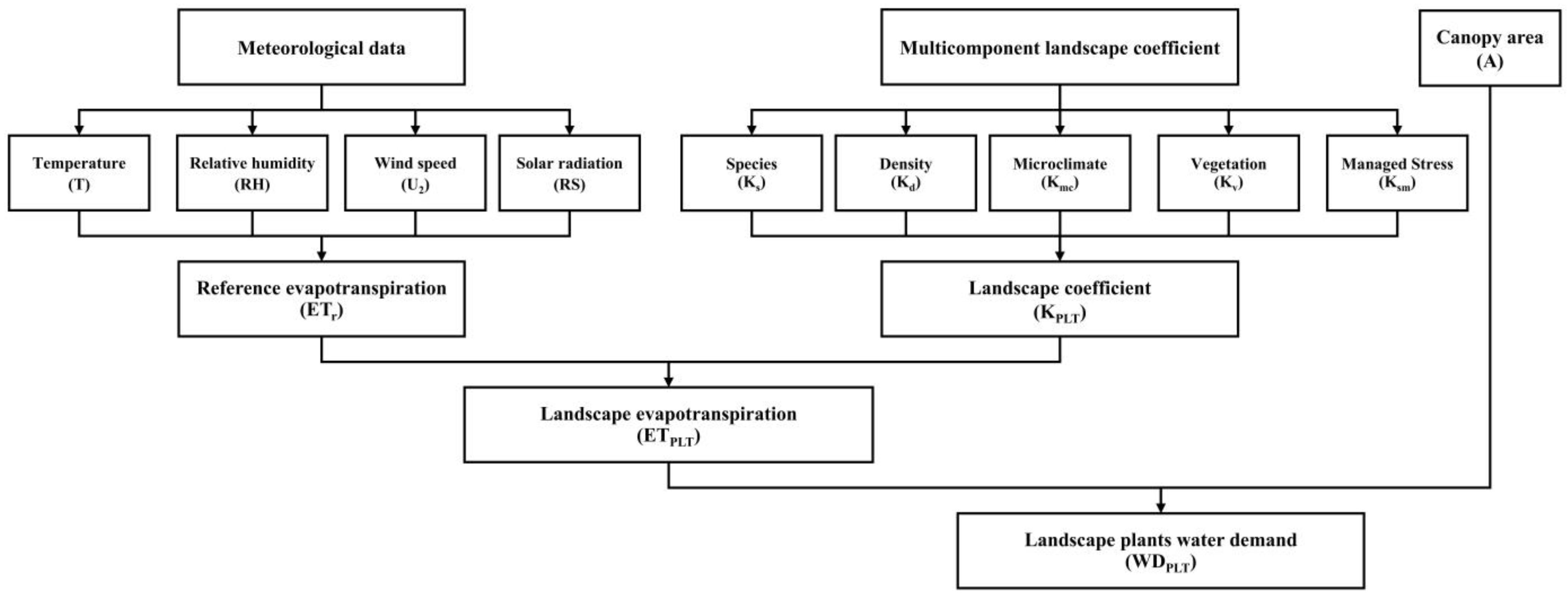

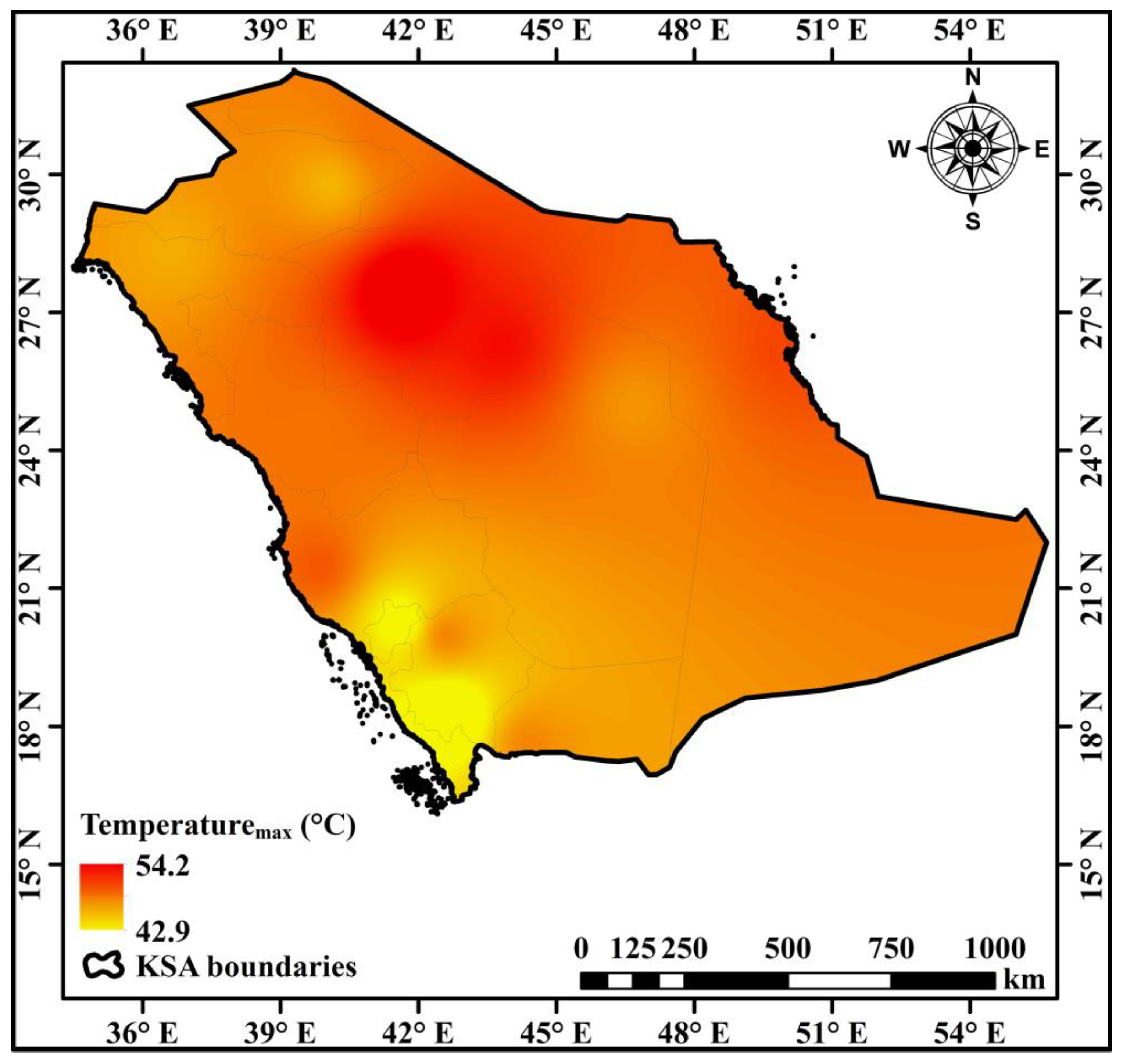
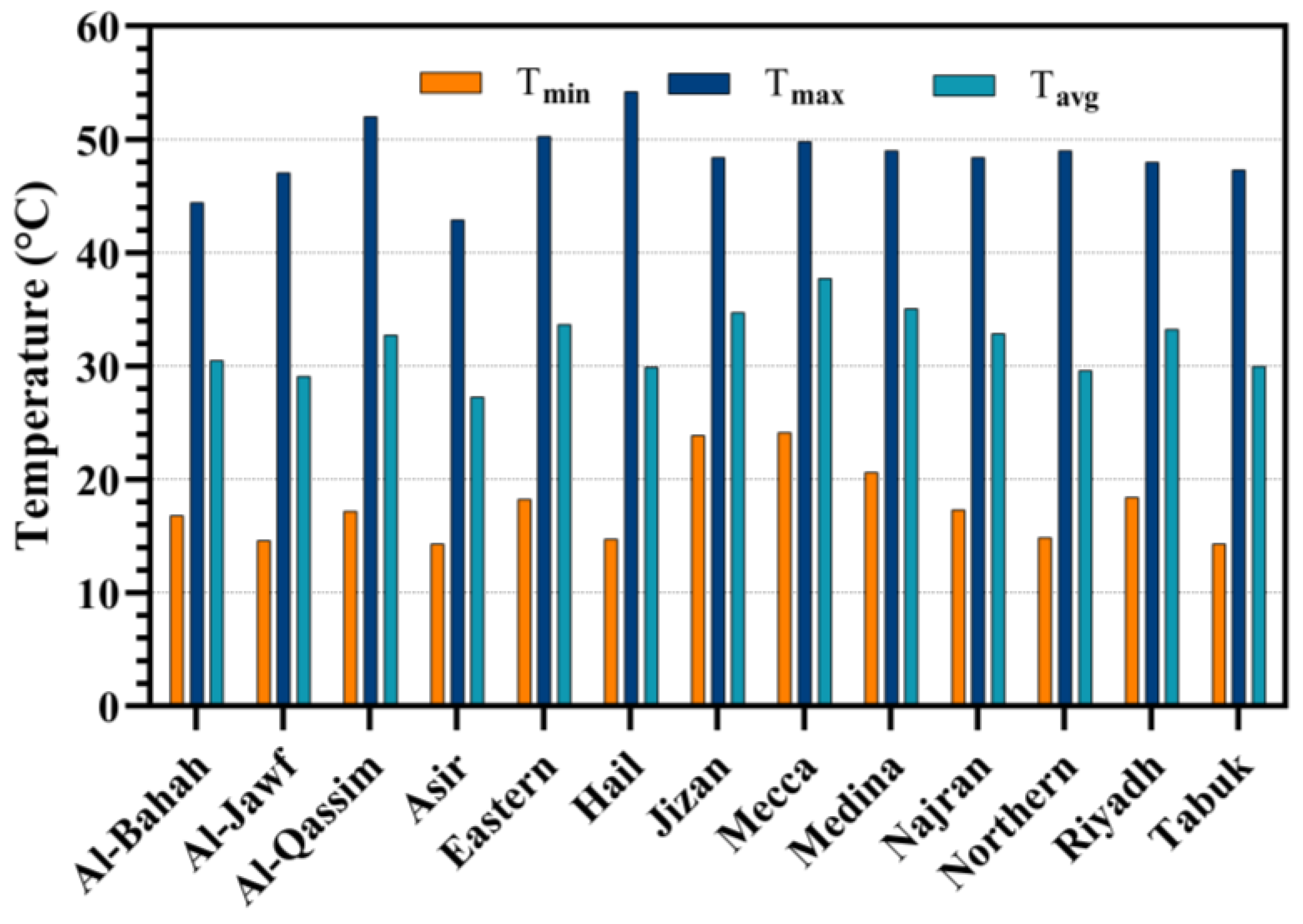
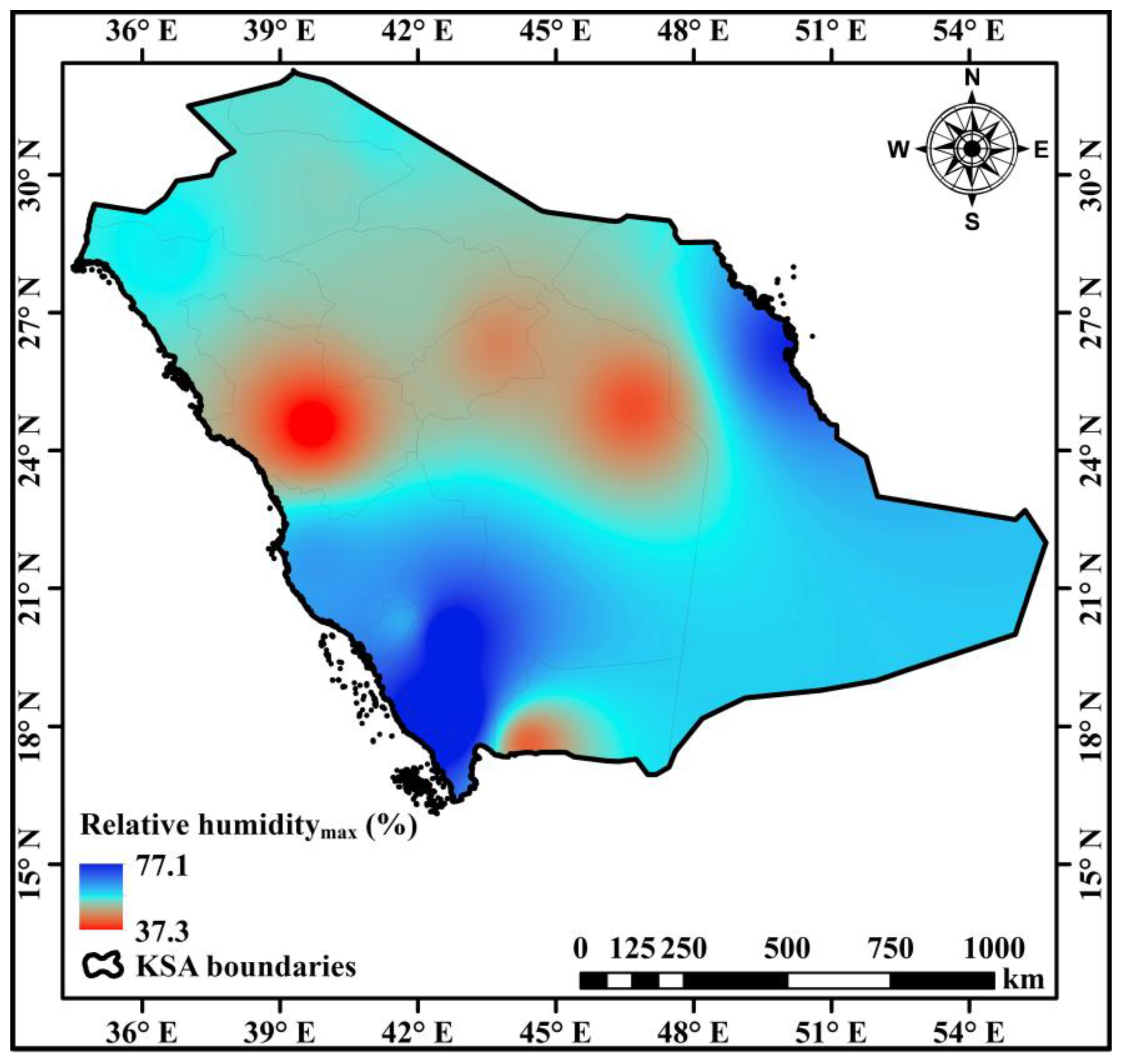


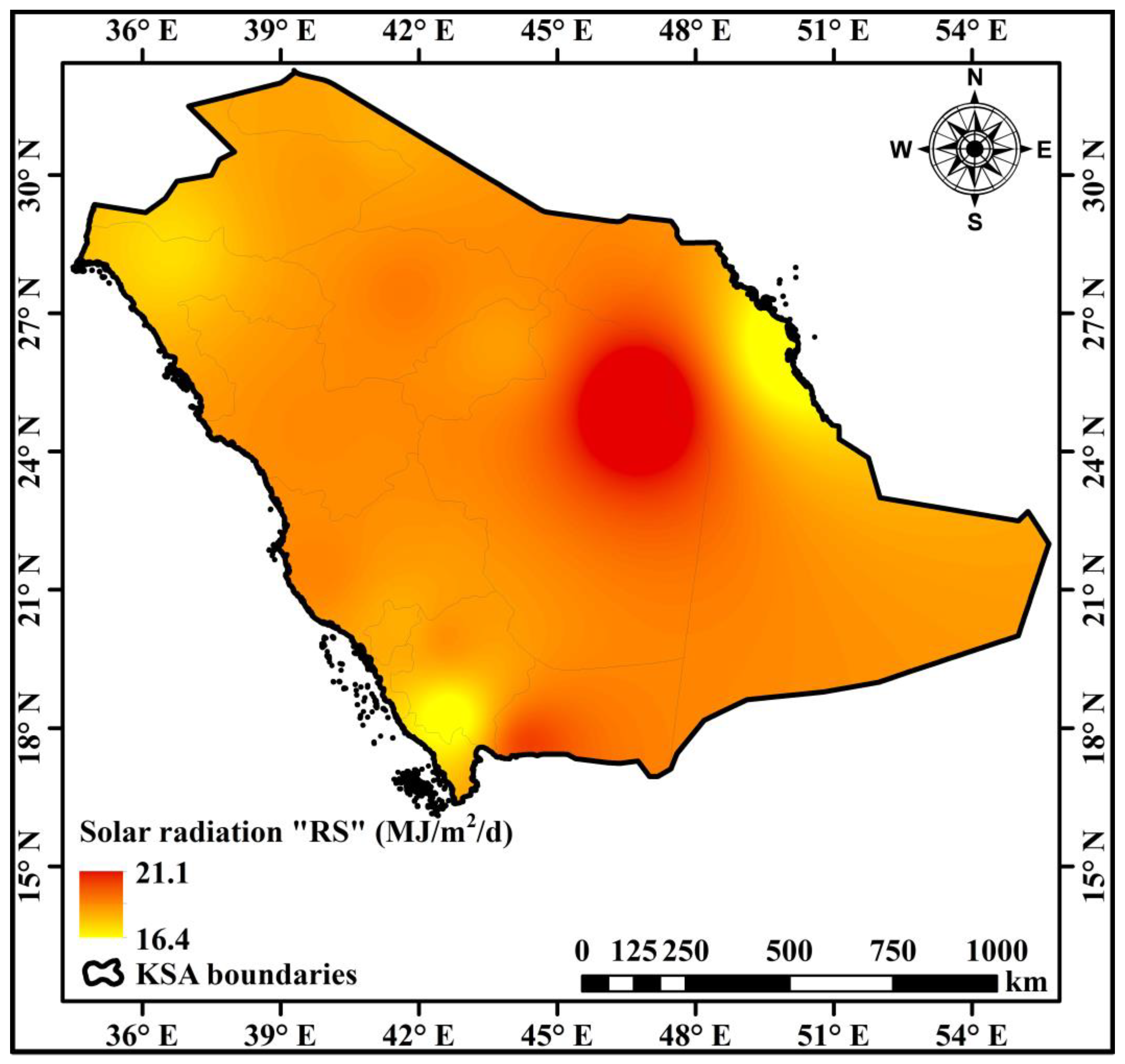
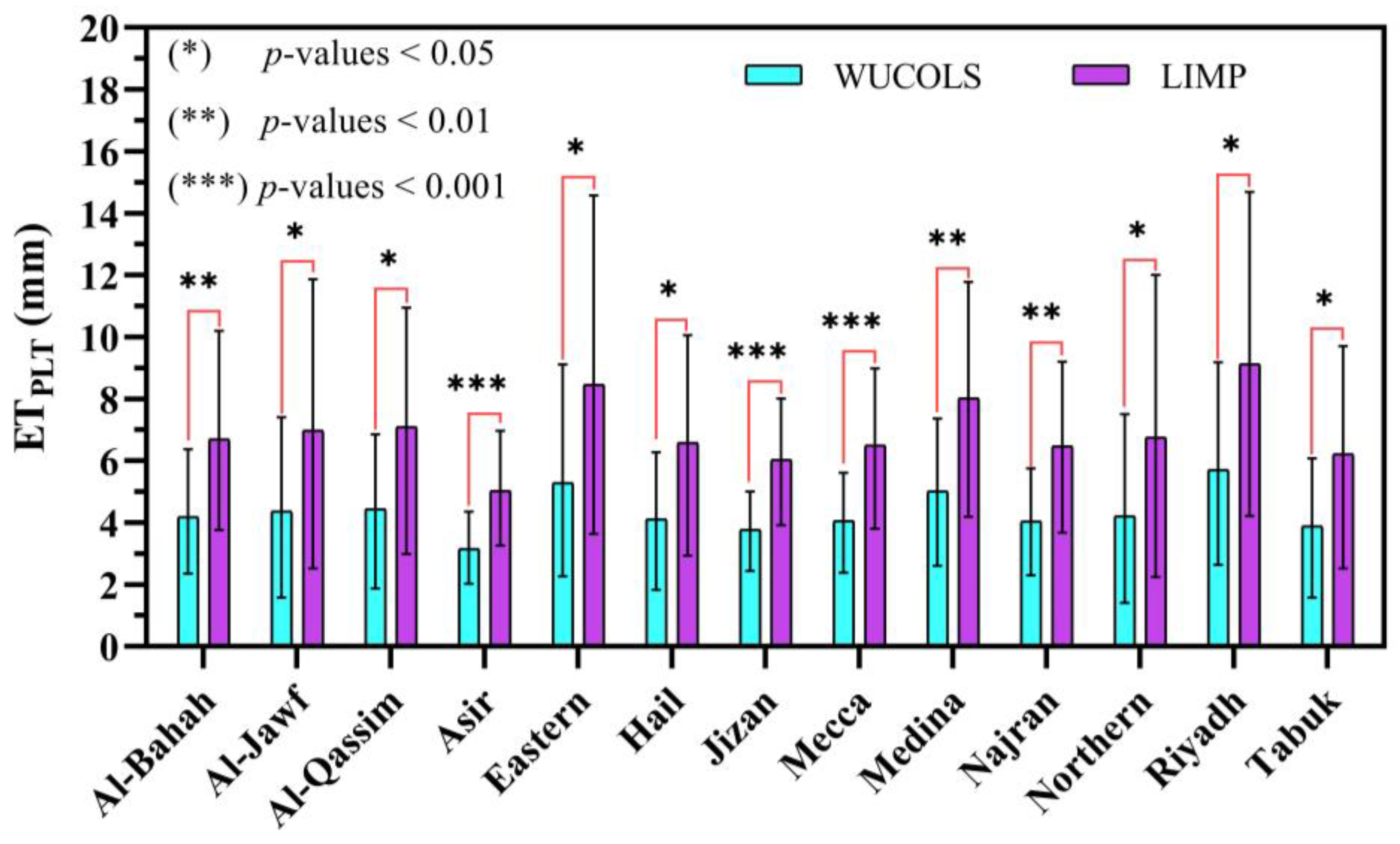
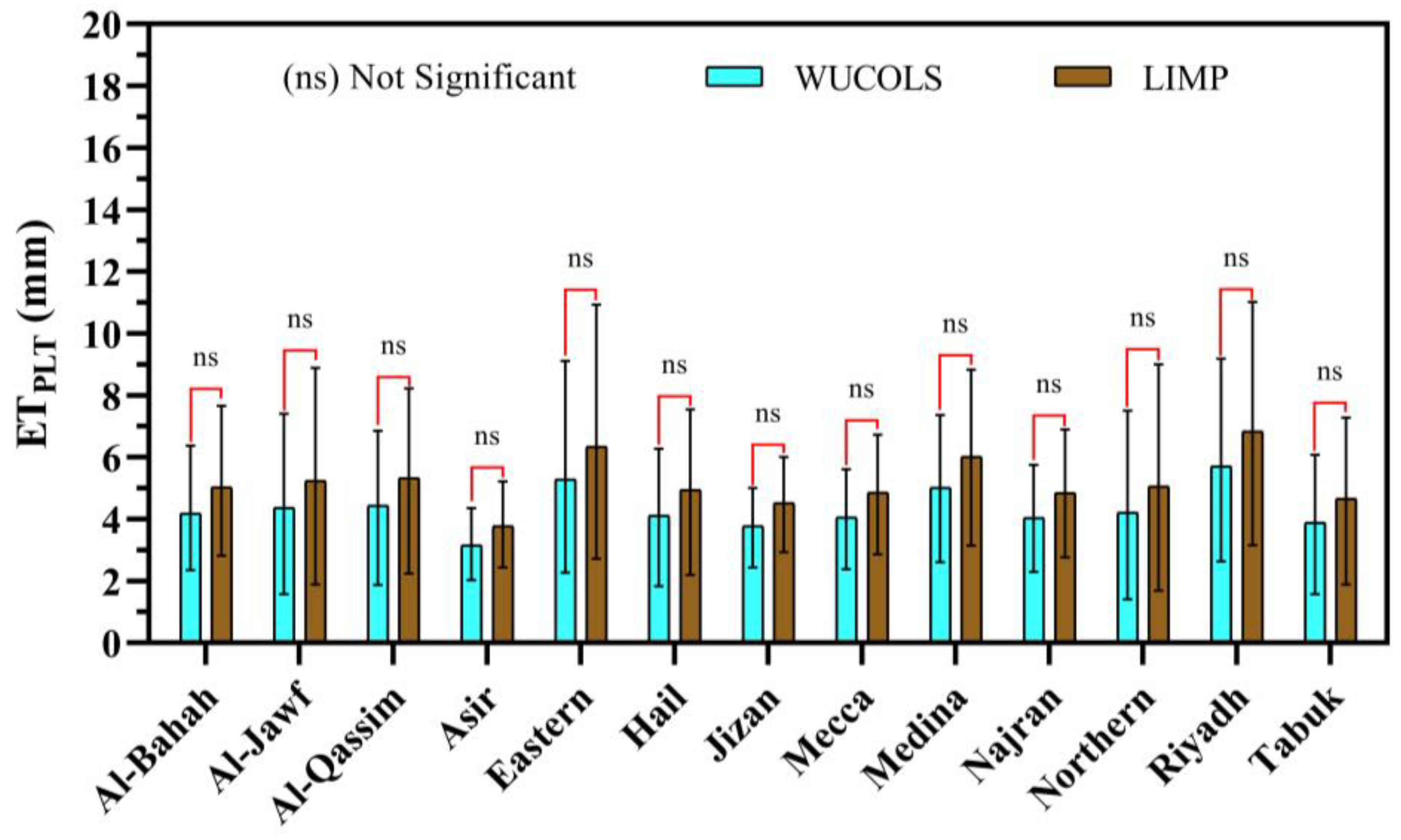
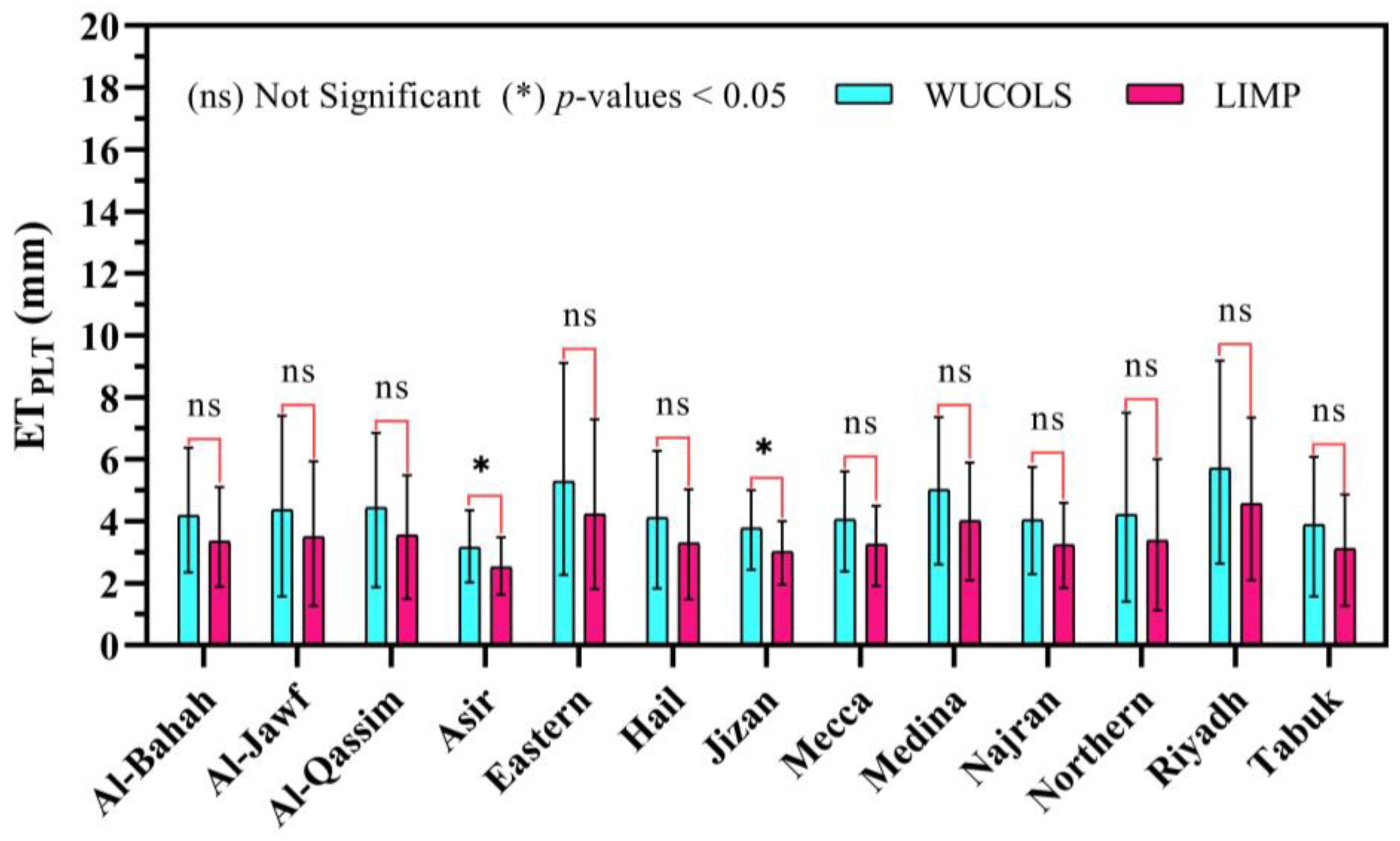
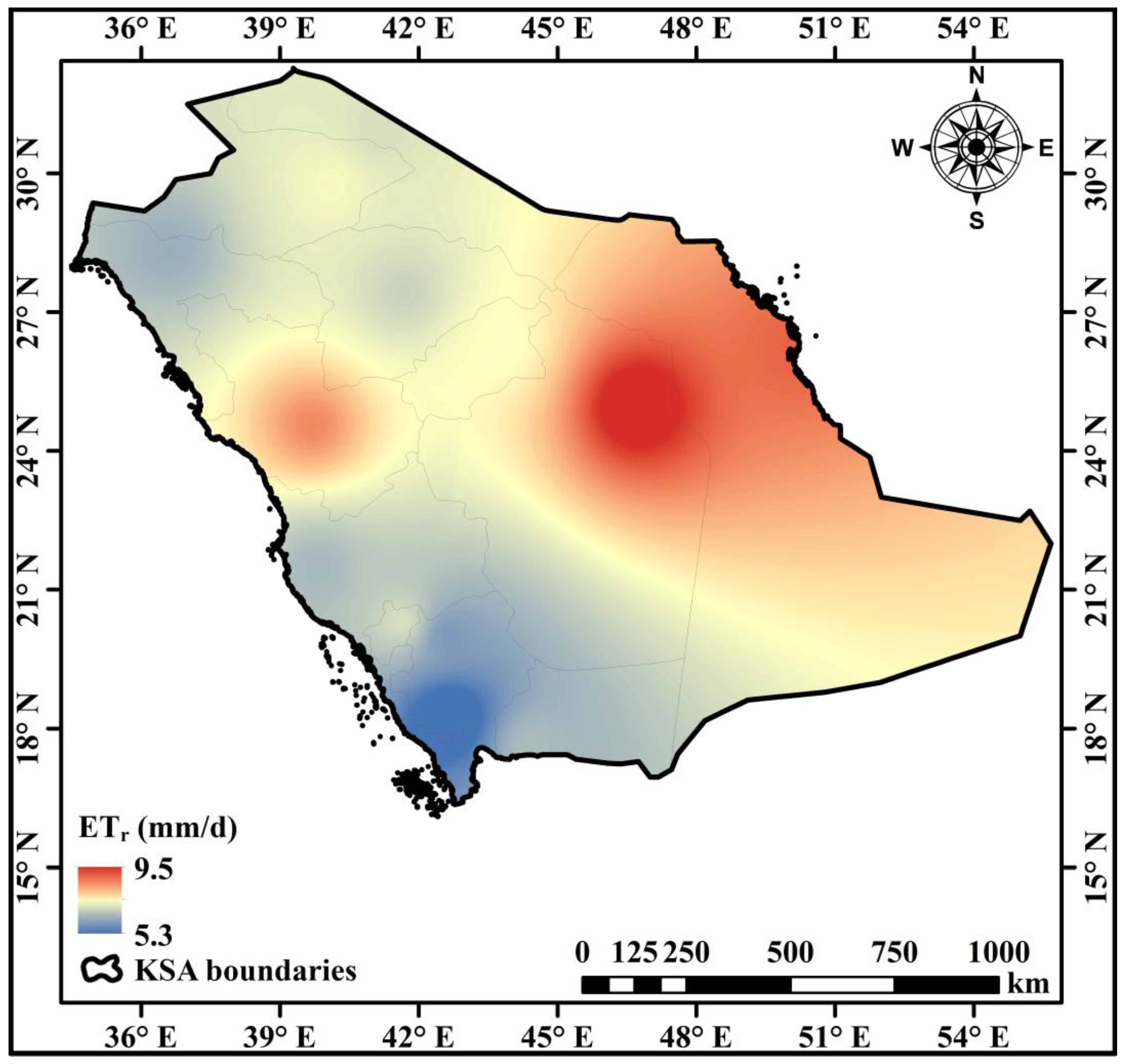
| Factor | Low | Moderate | High |
|---|---|---|---|
| Species (Ks) | 0.1–0.3 | 0.4–0.6 | 0.7–0.9 |
| Density (Kd) | 0.5–0.9 | 1 | 1.1–1.3 |
| Microclimate (Kmc) | 0.5–0.9 | 1 | 1.1–1.4 |
| Vegetation Category | Kv | Kmc | Ksm | ||||
|---|---|---|---|---|---|---|---|
| Low (b) | Mod. (c) | High (d) | Low | Mod. | High | ||
| Trees | 1.15 | 0.5 | 1.0 | 1.4 | 0.8 | 0.6 | 0.4 |
| Shrubs, desert species | 0.70 | 0.5 | 1.0 | 1.3 | 0.6 | 0.4 | 0.3 |
| Shrubs, non-desert species | 0.80 | 0.5 | 1.0 | 1.3 | 0.8 | 0.6 | 0.4 |
| Groundcover | 1.00 | 0.5 | 1.0 | 1.2 | 0.8 | 0.5 | 0.3 |
| Annuals | 0.90 | 0.5 | 1.0 | 1.2 | 0.8 | 0.7 | 0.5 |
| Mixture: trees, shrubs, and groundcover (a) | 1.20 | 0.5 | 1.0 | 1.4 | 0.8 | 0.6 | 0.4 |
| Turfgrass: cool season | 0.90 | 0.8 | 1.0 | 1.2 | 0.9 | 0.8 | 0.7 |
| Turfgrass: warm season | 0.90 | 0.8 | 1.0 | 1.2 | 0.8 | 0.7 | 0.6 |
| Region | January | February | March | |||||||||||||||
|---|---|---|---|---|---|---|---|---|---|---|---|---|---|---|---|---|---|---|
| WUCOLS | LIMP | WUCOLS | LIMP | WUCOLS | LIMP | |||||||||||||
| L | M | H | L | M | H | L | M | H | L | M | H | L | M | H | L | M | H | |
| Al-Bahah | 0.94 | 2.36 | 3.77 | 3.77 | 2.83 | 1.89 | 1.20 | 3.00 | 4.80 | 4.80 | 3.60 | 2.40 | 1.44 | 3.60 | 5.76 | 5.76 | 4.32 | 2.88 |
| Al-Jawf | 0.63 | 1.57 | 2.52 | 2.52 | 1.89 | 1.26 | 0.90 | 2.26 | 3.61 | 3.61 | 2.71 | 1.81 | 1.31 | 3.29 | 5.26 | 5.26 | 3.94 | 2.63 |
| Al-Qassim | 0.75 | 1.87 | 2.98 | 2.98 | 2.24 | 1.49 | 1.04 | 2.61 | 4.18 | 4.18 | 3.13 | 2.09 | 1.41 | 3.53 | 5.65 | 5.65 | 4.24 | 2.83 |
| Asir | 0.82 | 2.06 | 3.30 | 3.30 | 2.47 | 1.65 | 1.00 | 2.49 | 3.98 | 3.98 | 2.99 | 1.99 | 1.21 | 3.01 | 4.82 | 4.82 | 3.62 | 2.41 |
| Eastern | 0.91 | 2.27 | 3.63 | 3.63 | 2.72 | 1.81 | 1.10 | 2.75 | 4.39 | 4.39 | 3.29 | 2.20 | 1.54 | 3.86 | 6.18 | 6.18 | 4.63 | 3.09 |
| Hail | 0.75 | 1.88 | 3.01 | 3.01 | 2.26 | 1.50 | 1.01 | 2.53 | 4.04 | 4.04 | 3.03 | 2.02 | 1.33 | 3.34 | 5.34 | 5.34 | 4.00 | 2.67 |
| Jizan | 0.98 | 2.44 | 3.91 | 3.91 | 2.93 | 1.95 | 1.13 | 2.82 | 4.51 | 4.51 | 3.38 | 2.25 | 1.37 | 3.43 | 5.50 | 5.50 | 4.12 | 2.75 |
| Mecca | 0.95 | 2.38 | 3.82 | 3.82 | 2.86 | 1.91 | 1.20 | 2.99 | 4.79 | 4.79 | 3.59 | 2.40 | 1.52 | 3.80 | 6.09 | 6.09 | 4.57 | 3.04 |
| Medina | 1.05 | 2.61 | 4.18 | 4.18 | 3.14 | 2.09 | 1.33 | 3.33 | 5.33 | 5.33 | 4.00 | 2.67 | 1.75 | 4.37 | 6.99 | 6.99 | 5.24 | 3.49 |
| Najran | 0.98 | 2.45 | 3.93 | 3.93 | 2.94 | 1.96 | 1.27 | 3.17 | 5.07 | 5.07 | 3.80 | 2.54 | 1.55 | 3.86 | 6.18 | 6.18 | 4.64 | 3.09 |
| Northern Borders | 0.58 | 1.46 | 2.33 | 2.33 | 1.75 | 1.17 | 0.85 | 2.12 | 3.39 | 3.39 | 2.54 | 1.70 | 1.24 | 3.11 | 4.97 | 4.97 | 3.73 | 2.48 |
| Riyadh | 1.06 | 2.64 | 4.23 | 4.23 | 3.17 | 2.11 | 1.44 | 3.61 | 5.77 | 5.77 | 4.33 | 2.88 | 1.90 | 4.75 | 7.59 | 7.59 | 5.70 | 3.80 |
| Tabuk | 0.66 | 1.65 | 2.64 | 2.64 | 1.98 | 1.32 | 0.93 | 2.33 | 3.72 | 3.72 | 2.79 | 1.86 | 1.31 | 3.27 | 5.22 | 5.22 | 3.92 | 2.61 |
| Region | April | May | June | |||||||||||||||
| WUCOLS | LIMP | WUCOLS | LIMP | WUCOLS | LIMP | |||||||||||||
| L | M | H | L | M | H | L | M | H | L | M | H | L | M | H | L | M | H | |
| Al-Bahah | 1.59 | 3.98 | 6.37 | 6.37 | 4.78 | 3.18 | 1.85 | 4.62 | 7.38 | 7.38 | 5.54 | 3.69 | 2.37 | 5.93 | 9.49 | 9.49 | 7.12 | 4.74 |
| Al-Jawf | 1.84 | 4.59 | 7.35 | 7.35 | 5.51 | 3.67 | 2.33 | 5.83 | 9.33 | 9.33 | 7.00 | 4.67 | 2.76 | 6.89 | 11.02 | 11.02 | 8.27 | 5.51 |
| Al-Qassim | 1.85 | 4.62 | 7.39 | 7.39 | 5.55 | 3.70 | 2.43 | 6.09 | 9.74 | 9.74 | 7.30 | 4.87 | 2.73 | 6.84 | 10.94 | 10.94 | 8.20 | 5.47 |
| Asir | 1.31 | 3.27 | 5.23 | 5.23 | 3.92 | 2.61 | 1.49 | 3.73 | 5.96 | 5.96 | 4.47 | 2.98 | 1.74 | 4.35 | 6.96 | 6.96 | 5.22 | 3.48 |
| Eastern | 2.02 | 5.05 | 8.08 | 8.08 | 6.06 | 4.04 | 2.84 | 7.11 | 11.37 | 11.37 | 8.53 | 5.69 | 3.64 | 9.11 | 14.57 | 14.57 | 10.93 | 7.29 |
| Hail | 1.78 | 4.45 | 7.12 | 7.12 | 5.34 | 3.56 | 2.23 | 5.58 | 8.92 | 8.92 | 6.69 | 4.46 | 2.48 | 6.21 | 9.93 | 9.93 | 7.45 | 4.97 |
| Jizan | 1.61 | 4.03 | 6.44 | 6.44 | 4.83 | 3.22 | 1.80 | 4.49 | 7.19 | 7.19 | 5.39 | 3.59 | 1.94 | 4.85 | 7.77 | 7.77 | 5.83 | 3.88 |
| Mecca | 1.82 | 4.54 | 7.27 | 7.27 | 5.45 | 3.63 | 2.06 | 5.14 | 8.22 | 8.22 | 6.17 | 4.11 | 2.24 | 5.61 | 8.98 | 8.98 | 6.73 | 4.49 |
| Medina | 2.11 | 5.28 | 8.45 | 8.45 | 6.33 | 4.22 | 2.48 | 6.21 | 9.93 | 9.93 | 7.45 | 4.96 | 2.83 | 7.09 | 11.34 | 11.34 | 8.50 | 5.67 |
| Najran | 1.70 | 4.25 | 6.80 | 6.80 | 5.10 | 3.40 | 1.94 | 4.85 | 7.76 | 7.76 | 5.82 | 3.88 | 2.16 | 5.40 | 8.64 | 8.64 | 6.48 | 4.32 |
| Northern Borders | 1.78 | 4.46 | 7.13 | 7.13 | 5.35 | 3.57 | 2.37 | 5.92 | 9.47 | 9.47 | 7.10 | 4.74 | 2.78 | 6.94 | 11.11 | 11.11 | 8.33 | 5.55 |
| Riyadh | 2.40 | 6.01 | 9.62 | 9.62 | 7.21 | 4.81 | 2.98 | 7.46 | 11.94 | 11.94 | 8.95 | 5.97 | 3.58 | 8.95 | 14.33 | 14.33 | 10.74 | 7.16 |
| Tabuk | 1.75 | 4.38 | 7.01 | 7.01 | 5.26 | 3.51 | 2.15 | 5.37 | 8.59 | 8.59 | 6.44 | 4.30 | 2.41 | 6.03 | 9.65 | 9.65 | 7.23 | 4.82 |
| Region | July | August | September | |||||||||||||||
|---|---|---|---|---|---|---|---|---|---|---|---|---|---|---|---|---|---|---|
| WUCOLS | LIMP | WUCOLS | LIMP | WUCOLS | LIMP | |||||||||||||
| L | M | H | L | M | H | L | M | H | L | M | H | L | M | H | L | M | H | |
| Al-Bahah | 2.55 | 6.37 | 10.20 | 10.20 | 7.65 | 5.10 | 2.38 | 5.95 | 9.52 | 9.52 | 7.14 | 4.76 | 2.05 | 5.13 | 8.21 | 8.21 | 6.16 | 4.10 |
| Al-Jawf | 2.96 | 7.41 | 11.86 | 11.86 | 8.89 | 5.93 | 2.71 | 6.78 | 10.85 | 10.85 | 8.14 | 5.43 | 2.26 | 5.65 | 9.03 | 9.03 | 6.78 | 4.52 |
| Al-Qassim | 2.74 | 6.85 | 10.95 | 10.95 | 8.22 | 5.48 | 2.58 | 6.44 | 10.31 | 10.31 | 7.73 | 5.15 | 2.18 | 5.46 | 8.73 | 8.73 | 6.55 | 4.37 |
| Asir | 1.63 | 4.08 | 6.53 | 6.53 | 4.90 | 3.26 | 1.45 | 3.63 | 5.81 | 5.81 | 4.36 | 2.91 | 1.51 | 3.78 | 6.04 | 6.04 | 4.53 | 3.02 |
| Eastern | 3.51 | 8.79 | 14.06 | 14.06 | 10.54 | 7.03 | 3.05 | 7.61 | 12.18 | 12.18 | 9.14 | 6.09 | 2.54 | 6.35 | 10.16 | 10.16 | 7.62 | 5.08 |
| Hail | 2.51 | 6.28 | 10.05 | 10.05 | 7.54 | 5.03 | 2.35 | 5.87 | 9.39 | 9.39 | 7.04 | 4.69 | 2.02 | 5.06 | 8.09 | 8.09 | 6.07 | 4.05 |
| Jizan | 2.00 | 5.01 | 8.01 | 8.01 | 6.01 | 4.00 | 1.86 | 4.64 | 7.43 | 7.43 | 5.57 | 3.71 | 1.71 | 4.28 | 6.85 | 6.85 | 5.14 | 3.43 |
| Mecca | 2.14 | 5.36 | 8.57 | 8.57 | 6.43 | 4.28 | 2.00 | 5.01 | 8.02 | 8.02 | 6.01 | 4.01 | 1.84 | 4.59 | 7.35 | 7.35 | 5.51 | 3.68 |
| Medina | 2.94 | 7.36 | 11.78 | 11.78 | 8.83 | 5.89 | 2.81 | 7.03 | 11.25 | 11.25 | 8.44 | 5.63 | 2.41 | 6.04 | 9.66 | 9.66 | 7.24 | 4.83 |
| Najran | 2.30 | 5.75 | 9.20 | 9.20 | 6.90 | 4.60 | 2.16 | 5.41 | 8.66 | 8.66 | 6.49 | 4.33 | 1.90 | 4.74 | 7.58 | 7.58 | 5.69 | 3.79 |
| Northern Borders | 3.00 | 7.50 | 12.00 | 12.00 | 9.00 | 6.00 | 2.63 | 6.56 | 10.50 | 10.50 | 7.88 | 5.25 | 2.14 | 5.34 | 8.54 | 8.54 | 6.41 | 4.27 |
| Riyadh | 3.67 | 9.18 | 14.68 | 14.68 | 11.01 | 7.34 | 3.31 | 8.26 | 13.22 | 13.22 | 9.92 | 6.61 | 2.62 | 6.55 | 10.47 | 10.47 | 7.85 | 5.24 |
| Tabuk | 2.43 | 6.07 | 9.71 | 9.71 | 7.28 | 4.86 | 2.28 | 5.69 | 9.11 | 9.11 | 6.83 | 4.55 | 1.91 | 4.77 | 7.63 | 7.63 | 5.72 | 3.82 |
| Region | October | November | December | |||||||||||||||
| WUCOLS | LIMP | WUCOLS | LIMP | WUCOLS | LIMP | |||||||||||||
| L | M | H | L | M | H | L | M | H | L | M | H | L | M | H | L | M | H | |
| Al-Bahah | 1.64 | 4.11 | 6.58 | 6.58 | 4.93 | 3.29 | 1.14 | 2.86 | 4.57 | 4.57 | 3.43 | 2.29 | 0.94 | 2.35 | 3.76 | 3.76 | 2.82 | 1.88 |
| Al-Jawf | 1.65 | 4.11 | 6.58 | 6.58 | 4.94 | 3.29 | 0.96 | 2.40 | 3.83 | 3.83 | 2.87 | 1.92 | 0.65 | 1.61 | 2.58 | 2.58 | 1.94 | 1.29 |
| Al-Qassim | 1.69 | 4.22 | 6.76 | 6.76 | 5.07 | 3.38 | 1.13 | 2.81 | 4.50 | 4.50 | 3.38 | 2.25 | 0.76 | 1.90 | 3.04 | 3.04 | 2.28 | 1.52 |
| Asir | 1.22 | 3.05 | 4.89 | 4.89 | 3.66 | 2.44 | 0.92 | 2.29 | 3.67 | 3.67 | 2.75 | 1.83 | 0.81 | 2.03 | 3.25 | 3.25 | 2.44 | 1.63 |
| Eastern | 1.93 | 4.82 | 7.71 | 7.71 | 5.78 | 3.85 | 1.35 | 3.37 | 5.40 | 5.40 | 4.05 | 2.70 | 0.95 | 2.37 | 3.80 | 3.80 | 2.85 | 1.90 |
| Hail | 1.59 | 3.97 | 6.35 | 6.35 | 4.76 | 3.18 | 0.97 | 2.42 | 3.88 | 3.88 | 2.91 | 1.94 | 0.73 | 1.83 | 2.93 | 2.93 | 2.20 | 1.47 |
| Jizan | 1.51 | 3.79 | 6.06 | 6.06 | 4.54 | 3.03 | 1.20 | 3.01 | 4.82 | 4.82 | 3.61 | 2.41 | 1.00 | 2.49 | 3.99 | 3.99 | 2.99 | 2.00 |
| Mecca | 1.59 | 3.98 | 6.36 | 6.36 | 4.77 | 3.18 | 1.16 | 2.90 | 4.65 | 4.65 | 3.48 | 2.32 | 0.95 | 2.38 | 3.81 | 3.81 | 2.86 | 1.91 |
| Medina | 1.87 | 4.68 | 7.50 | 7.50 | 5.62 | 3.75 | 1.39 | 3.48 | 5.57 | 5.57 | 4.18 | 2.78 | 1.09 | 2.71 | 4.34 | 4.34 | 3.26 | 2.17 |
| Najran | 1.44 | 3.60 | 5.76 | 5.76 | 4.32 | 2.88 | 1.09 | 2.73 | 4.36 | 4.36 | 3.27 | 2.18 | 0.92 | 2.30 | 3.68 | 3.68 | 2.76 | 1.84 |
| Northern Borders | 1.49 | 3.73 | 5.96 | 5.96 | 4.47 | 2.98 | 0.83 | 2.08 | 3.33 | 3.33 | 2.50 | 1.67 | 0.56 | 1.40 | 2.24 | 2.24 | 1.68 | 1.12 |
| Riyadh | 1.94 | 4.84 | 7.75 | 7.75 | 5.81 | 3.88 | 1.42 | 3.56 | 5.70 | 5.70 | 4.27 | 2.85 | 1.05 | 2.63 | 4.21 | 4.21 | 3.16 | 2.10 |
| Tabuk | 1.36 | 3.39 | 5.43 | 5.43 | 4.07 | 2.71 | 0.86 | 2.14 | 3.43 | 3.43 | 2.57 | 1.71 | 0.63 | 1.58 | 2.52 | 2.52 | 1.89 | 1.26 |
Disclaimer/Publisher’s Note: The statements, opinions and data contained in all publications are solely those of the individual author(s) and contributor(s) and not of MDPI and/or the editor(s). MDPI and/or the editor(s) disclaim responsibility for any injury to people or property resulting from any ideas, methods, instructions or products referred to in the content. |
© 2025 by the authors. Licensee MDPI, Basel, Switzerland. This article is an open access article distributed under the terms and conditions of the Creative Commons Attribution (CC BY) license (https://creativecommons.org/licenses/by/4.0/).
Share and Cite
Alazba, A.A.; Mattar, M.A.; El-Shafei, A.; Ezzeldin, M.; Radwan, F.; Alrdyan, N. Water Demand Determination for Landscape Using WUCOLS and LIMP Mathematical Models. Water 2025, 17, 1429. https://doi.org/10.3390/w17101429
Alazba AA, Mattar MA, El-Shafei A, Ezzeldin M, Radwan F, Alrdyan N. Water Demand Determination for Landscape Using WUCOLS and LIMP Mathematical Models. Water. 2025; 17(10):1429. https://doi.org/10.3390/w17101429
Chicago/Turabian StyleAlazba, A. A., Mohamed A. Mattar, Ahmed El-Shafei, Mahmoud Ezzeldin, Farid Radwan, and Nasser Alrdyan. 2025. "Water Demand Determination for Landscape Using WUCOLS and LIMP Mathematical Models" Water 17, no. 10: 1429. https://doi.org/10.3390/w17101429
APA StyleAlazba, A. A., Mattar, M. A., El-Shafei, A., Ezzeldin, M., Radwan, F., & Alrdyan, N. (2025). Water Demand Determination for Landscape Using WUCOLS and LIMP Mathematical Models. Water, 17(10), 1429. https://doi.org/10.3390/w17101429










